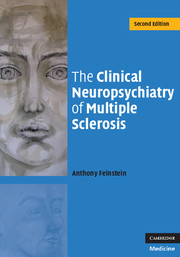Book contents
- Frontmatter
- Contents
- Acknowledgement
- Foreword
- 1 Multiple sclerosis: diagnosis and definitions
- 2 Depression: prevalence, symptoms, diagnosis and clinical correlates
- 3 Depression: etiology and treatment
- 4 Multiple sclerosis, bipolar affective disorder and euphoria
- 5 Multiple sclerosis and pseudobulbar affect
- 6 Multiple sclerosis and psychosis
- 7 Cognitive impairment in multiple sclerosis
- 8 The natural history of cognitive change in multiple sclerosis
- 9 Cognitive impairment in multiple sclerosis: detection, management and significance
- 10 Neuroimaging correlates of cognitive dysfunction
- 11 Multiple sclerosis, disease-modifying treatments and behavioral change
- 12 Multiple sclerosis: a subcortical, white matter dementia?
- Index
- Plate section
- References
10 - Neuroimaging correlates of cognitive dysfunction
Published online by Cambridge University Press: 13 August 2009
- Frontmatter
- Contents
- Acknowledgement
- Foreword
- 1 Multiple sclerosis: diagnosis and definitions
- 2 Depression: prevalence, symptoms, diagnosis and clinical correlates
- 3 Depression: etiology and treatment
- 4 Multiple sclerosis, bipolar affective disorder and euphoria
- 5 Multiple sclerosis and pseudobulbar affect
- 6 Multiple sclerosis and psychosis
- 7 Cognitive impairment in multiple sclerosis
- 8 The natural history of cognitive change in multiple sclerosis
- 9 Cognitive impairment in multiple sclerosis: detection, management and significance
- 10 Neuroimaging correlates of cognitive dysfunction
- 11 Multiple sclerosis, disease-modifying treatments and behavioral change
- 12 Multiple sclerosis: a subcortical, white matter dementia?
- Index
- Plate section
- References
Summary
This chapter will review structural and functional brain imaging correlates of cognitive dysfunction. The emphasis will be on MRI given the sensitivity of this technique in demonstrating MS pathology in the brain. It is no coincidence that the renewed interest shown by researchers in the neurobehavioral sequelae of MS dates from the advent of MRI as a research and clinical tool in the 1980s. The use of MRI provides a window into the brain of MS patients and offers an unprecedented opportunity to delineate the cerebral correlates of cognitive dysfunction. While MRI–cognitive studies initially largely focussed on lesion detection and the quantification of lesion volume, attention has shifted more recently to markers of cerebral atrophy as potentially more powerful correlates of cognitive dysfunction. In addition, newer MRI techniques such as diffusion tensor imaging (DTI) and magnetization transfer ratios (MTR), which provide information on normal appearing brain tissue have offered clues concerning the pathogenesis of impaired cognition. These data are complemented by those from a small literature devoted to nuclear magnetic resonance (NMR) spectroscopy and the findings pertaining to cognition will also be reviewed. Finally, insights into cognitive dysfunction derived from functional brain imaging will be discussed. Here too there has been a recent shift in emphasis, this time away from positron emission tomography (PET) and single photon emission computed tomography (SPECT) scanning to the rapidly evolving modality of functional MRI (fMRI).
- Type
- Chapter
- Information
- The Clinical Neuropsychiatry of Multiple Sclerosis , pp. 178 - 213Publisher: Cambridge University PressPrint publication year: 2007



